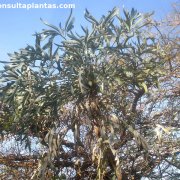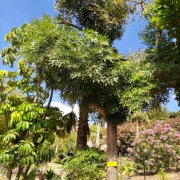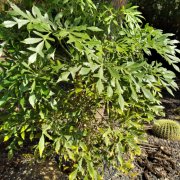Care of the tree Cussonia paniculata or Mountain cabbage tree |
|
The genus Cussonia, family Araliaceae, includes 20 species of trees and shrubs native to Africa. Some species are: Cussonia paniculata, Cussonia spicata, Cussonia arborea, Cussonia transvaalensis, Cussonia holstii. Common name: Mountain cabbage tree. This species is native to South Africa. They are small trees or large semi-perennial shrubs with succulent roots and a wide crown that reach 8 meters (26.24 feet) in height. The attractive, waxy-textured leaves are large (up to 60 cm/23.6") and have large (7-9) blue-green lobes. They produce cylindrical spikes filled with small yellowish-green flowers that attract butterflies and bees. They bloom in late summer. In autumn, fleshy purple fruits appear. These slow-growing plants are used in small gardens as isolated specimens, in public parks and walks, or in pots for patios and terraces. Cussonia paniculata prefers a semi-shade exposure in its youth and full sun when it is settled. It resists weak frosts but it is better not to expose it to less than 5 ºC (41 ºF). The soil must be well drained and contain organic matter. The pot transplant is done in spring; the roots are quite delicate. Water regularly in spring and summer, waiting for the soil to dry out completely; it's important never to flood. Mountain cabbage tree resists a few days of drought. Fertilize with compost or manure in early spring. Prune in late winter to remove dry branches and inflorescences. Cussonia paniculata is a quite resistant plant to the usual pests and diseases. Mountain cabbage tree propagate by seeds sown before 3 months from their collection (they lose germination capacity) in a sandy and humid substrate. They can take between 4 and 7 weeks to germinate; in summer they germinate faster. |
Images of the tree Cussonia paniculata or Mountain cabbage tree |
Find plants
Cussonia paniculata or Mountain cabbage tree | Care and Growing
© 2025 FavThemes


